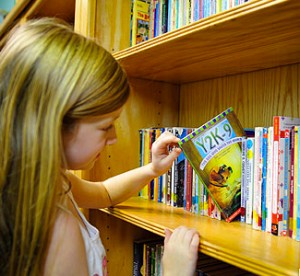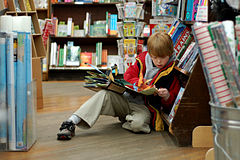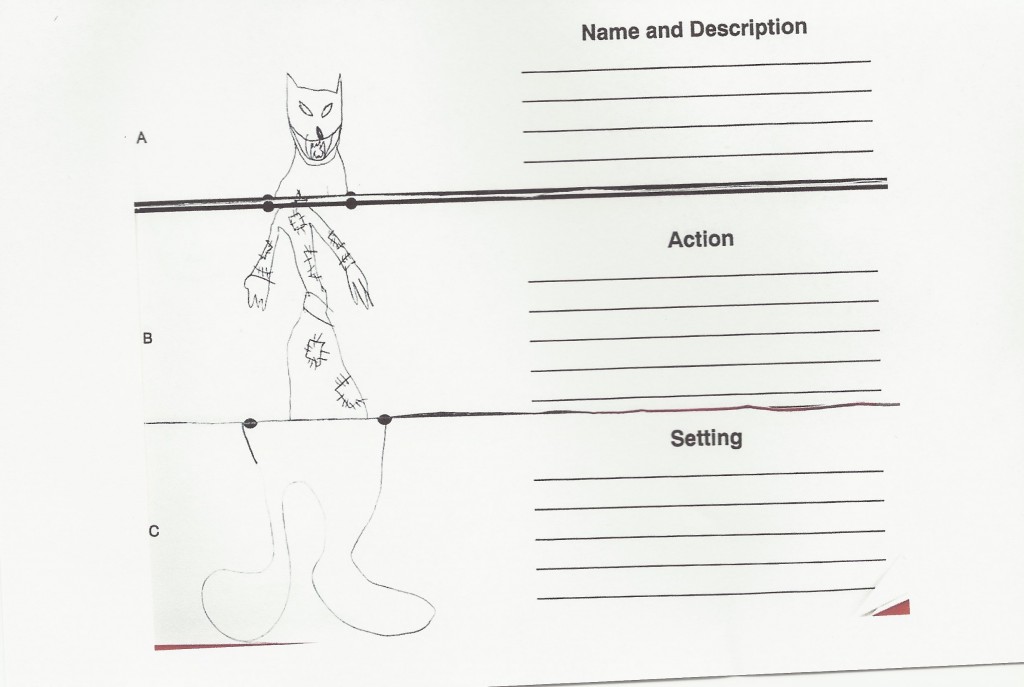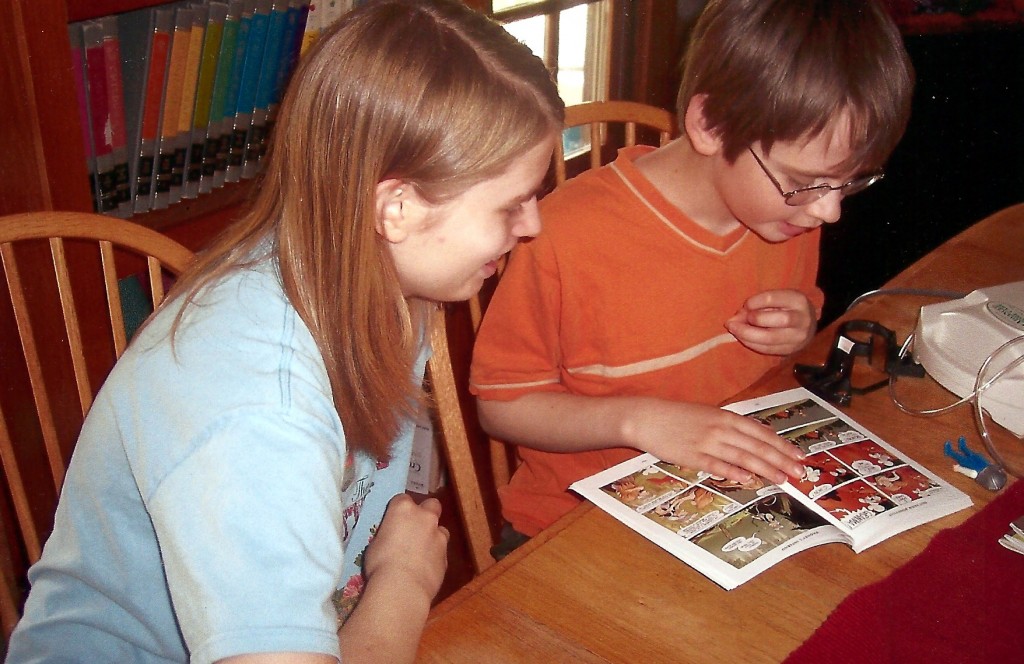There’s so much pressure around learning to read in our culture. Not just learning to read, but learning to read early. We have come to associate early reading with higher intelligence or a sign of future academic success.
This is a big problem for most right-brained learners who typically will begin to learn to read between 8 and 10 years old. This is considered “late” in our culture but absolutely normal for this brain processing preference. And for those right-brained learners who are even later readers of between 11 and 13, it outright panics parents.
The prevalent choice in our culture is to test these children for a learning disability, whether it be dyslexia, vision processing disorder, or other brain exercise needs. Behind almost every learning disability label is a right-brained child. This alone is evidence that the right-brained information is not recognized, understood, or honored.
 For those who find my right-brained information about later reading acquisition being normal for these learners with the evidence as to why, it can make sense. But, it’s scary to consider. Many feel it’s a choice between doing something (getting testing and remediation) or doing nothing.
For those who find my right-brained information about later reading acquisition being normal for these learners with the evidence as to why, it can make sense. But, it’s scary to consider. Many feel it’s a choice between doing something (getting testing and remediation) or doing nothing.
Supporting right-brained children in their natural reading development is not about doing nothing. There is much to do actually. What I discovered as I learned to shift my thinking about early reading (and other subject) acquisition is that I was forced to adopt a different style of interaction and facilitation with my creative children. Instead of teaching them reading skills, I promoted a positive relationship with print.
I have come to find out that this style of learning environment is more apt to develop children who enjoy reading that continues into adulthood. They are  more likely to love to learn because they are intrinsically motivated as well as more self-determined because of their experience with natural autonomous choices. Compare those attributes with children labeled with learning disabilities who have been put through years of remediation. They learn shame, fear, struggle, dependence, and weakness that leads to anxiety, anger, depression, family and self-image issues. For me, the decision was self-evident.
more likely to love to learn because they are intrinsically motivated as well as more self-determined because of their experience with natural autonomous choices. Compare those attributes with children labeled with learning disabilities who have been put through years of remediation. They learn shame, fear, struggle, dependence, and weakness that leads to anxiety, anger, depression, family and self-image issues. For me, the decision was self-evident.
How can a parent promote a positive relationship with print for their right-brained child? I talk about the stages of learning and how to support it in Chapter Eleven of my book, The Right Side of Normal. I also asked my readers to chime in with their experiences.
From my book, Chapter Eleven:
I can’t stress enough the importance of creative outlets in the lives of right-brained, creative people. These activities inherently develop and showcase the strengths of a right-brained person (see Chapter Six). Creative outlets help visualization skills develop naturally.
Regarding the creative outlet, theater/showmanship:
From Robyn:
My daughter loved to build “play scenes” with all her toys. She would act out a play, and I would write it down. Then we would read back over the story she “wrote.” Today she is 13, and I cherish those stories and memories so much!
From Tracy:
My youngest two write puppet shows and make their own puppets, then there is a show.
From the creative outlet, art/photography:
From Chassidy:
Our daughter loves to draw. She illustrated a story and her friend wrote the words. They had to collaborate and go back over the words multiple times to make sure everything was right. They enjoyed it.
I shared:
My artist son in particular loved to make visuals books. Read! Write! Publish! was a well-used resource. My other children have had their own versions of made-up visual books.
From the creative outlet, Puzzles/Mazes:
From Lynne:
My 7 year old loves puzzles and so I found large puzzle pieces (just a left and right side for each little puzzle) and then went online to find fun or funny pictures that she’d like and wrote a description of each. She was so motivated to read through each one so that she could find the match it surprised me!
The creative outlet, Cooking/Gardening:
From Annette:
(We call it “potions” or “chemistry.”) I ask before dashing to the grocery store, “what should we brew up for dinner?” Sometimes, they already have the recipe bookmarked, but more often than not, it’s something like, “I want that mac-n-cheese from Cracker Barrel” and I say, “Great. Get me a recipe.” Then they have to scour the internet for the “Cracker Barrel Macaroni and Cheese Recipe”. (Yes, it’s out there on the internet.)
My friend, Stephanie from Throwing Marshmallows likes to say, Everything Counts. Here are some more ideas along these lines from my readers:
From Melissa:
My son plays Scribblenauts, which requires them to read and spell words in order to pass levels. He picks his own books at the library. He prefers movies, so he has to pick as many books as movies. We use the captions on our TV when we watch movies. No pressure, no drills, no lessons. Just plenty of opportunities to be exposed to the written word. He taught himself and is a proficient reader at age 7.
My kids, both left & right brained, LOVE Shel Silverstein and other silly poetry in that style. They have a routine they do where they play the parts in the “1-2 Buckle My Shoe” Poem. So funny!
Summer said:
My daughter makes up stories and I write them down as she speaks. Then she ends up correcting my punctuation if it doesn’t sound right when I read the sentence back. It takes the pressure off spelling and she loves to read her own stories.
From Elizabeth:
I just spoke with someone tonight who mentioned doing a play on words type of thing… it’s a book called “Delightful Reading” based on Charlotte Mason’s method of teaching. You start with the word tall, then they get that picture in their head instead of spelling t-a-l-l. But then next you remove the t and ask them to put other letters to make new words…all kinds of words come to mind like ball, mall etc…so they are associating the words with pictures in their heads.
Annette shared more:
Computer games – tons of reading involved computer/programming related instruction – Mega-tons of reading involved, plus they can supplement with Youtube tutorial videos, etc.
One kid is in the habit of checking the news on her Google homepage every morning. She created links to a broad-spectrum of news reports – conservative, liberal, midland, global, etc. I’m shocked by how aware she is of what’s going on in the world and I’ve noticed DS beginning to “check-in” with the world.
Magazines geared toward their interests. We subscribe to Game Informer, Wired, This Old House, Country Living, (and my latest one, AARP. Ugh.) And I’ll pick up the odd magazine at the check-out. There’s a science magazine I typically grab, the name of which eludes me at present, but it always has some pretty catchy graphics on the front cover. The last issue had an article on the Higgs Boson particle with a great diagram of CERN, (and a scale of the size. Huge.) which launched an investigation of the Higgs Boson study, the collider, then other research that’s going on off the coast of Africa. (Did you know tests have been successful for “transporting” photon particles?)
And then there are TED videos. I know, I know, they’re not text based, but they always, but ALWAYS launch an exploration of something that is text based. Following the program we saw on transporting photons, we saw the TED video on 3-D printing pharmaceuticals, which is a hairsbreadth away from a replicator – and Star Trek is coming out this week.
But my point is, everything is a reading support. Just because your child might not enjoy curling up with a good book, doesn’t mean they’re not reading.
Ye Jin Cho reiterates my philosophy with more ideas:
I’ve tried to adopt the mindset, that it doesn’t matter if he is reading at 5 but rather is he STILL reading at 25, 45, 85? So we try to foster the love of learning and reading by these methods:
-Audiobooks – We love the Boxcar Children, Nate the Great, all the Roald Dahl books. I feel it helps with auditory processing as well.
-Library books galore – We max out our library cards and just get tons of beautifully illustrated books, non-fiction, and chapter books. We read aloud as much as time allows, sometimes hours, sometimes only 20 minutes. We have books in every room of our house to create an environment that makes it hard NOT to read.
-Newspaper – I allow my son to peruse the NY Times with me. There is something great about flipping through the paper with breakfast (don’t worry, we reuse the paper as gift wrap, crafts, or other things) Some of the material is a bit graphic but he is interested in REAL news, not kid news. So he tries to read these articles because he is curious about his world. We discuss the world events, and he feels so important when he is part of a relevant discussion with adults.
-Mad Libs – I use these for grammar practice, but my son thinks these are hilarious. So with help, we work on Mad Libs, or he can do Jr. Mad Libs on his own. He enjoys reading the stories because they are so stinking silly and he cracks himself up.
-Silly books – I know that many theories are that we shouldn’t allow our kids to read “fluff”, but my son loves Captain Underpants books. Not my fave (very annoying), but he thinks they are hilarious. He reads them on his own which is a huge step from where he was last year while in public school and refusing to read because he thought he was stupid.
Phonics was a disaster. It simply did not work for us. It seriously made him more confused. The English language is so frustrating because there are SO many exceptions to the rules. So increased exposure to words with pictures and picture books, he is seriously imprinting these words in his mind along with the story.
As you can see, this “doing nothing” is a whole lot more than it seems. In fact, throwing flashcards in front of faces with blank looks is a LOT easier than enriching their lives and fostering a love for books. I feel that in our approach, we are making reading relevant, interesting, and important.
To me, if a child can read early by means of forcing something that is not natural, they may be able to pass the test, but what if the child learns to hate reading because of this? Is this success?
The reason I didn’t panic about my children’s later reading (and other subject) acquisition is that I saw they had a positive relationship with print by doing many of the things listed above. I learned a lot of important information along the way, such as why comic books work so well for right-brained children as early reading material. Or why right-brained children tend to do better as silent readers than reading aloud to someone.
I hope these experiences and ideas give you inspiration to promote a positive relationship with print with your right-brained child. It did for me with my younger boys. I found that since they were not as naturally drawn to books in their early years, I have neglected facilitating more of these experiences in their later years. My youngest immediately perked up as he remembered the stories his sister made for him some years ago. He initiated reading the first page right off. So, I’m recommitted. I know it’s well worth the effort!
What are some of your ideas and experiences with promoting a positive relationship with print for your right-brained children?









Pingback: All About Spelling | The Right Side of Normal
Pingback: Your Child Might Be Right-Brained If … | The Right Side of Normal